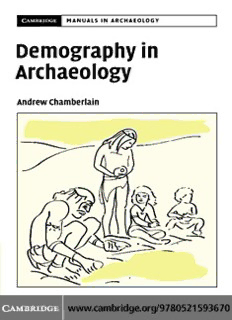
DEMOGRAPHY IN ARCHAEOLOGY - Academia.dk PDF
Preview DEMOGRAPHY IN ARCHAEOLOGY - Academia.dk
This page intentionally left blank DEMOGRAPHY IN ARCHAEOLOGY DemographyinArchaeologyisareviewofcurrenttheoryandmethodinthereconstruction ofpopulationsfromarchaeologicaldata.Startingwithasummaryofdemographicconcepts andmethods,thebookexamineshistoricalandethnographicsourcesofdemographicevidence beforeaddressingthemethodsbywhichreliabledemographicestimatescanbemadefrom skeletalremains,settlementevidenceandmodernandancientbiomolecules.Recentdebates in palaeodemography are evaluated, new statistical methods for palaeodemographic recon- structionareexplained,andthenotionthatpastdemographicstructuresandprocesseswere substantiallydifferentfromthosepertainingtodayiscritiqued.Thebookcoversawidespanof evidence,fromtheevolutionarybackgroundofhumandemographytotheinfluenceofnatural andhuman-inducedcatastrophesonpopulationgrowthandsurvival.Thisisessentialread- ingforanyarchaeologistoranthropologistwithaninterestinrelatingtheresultsoffieldand laboratorystudiestobroaderquestionsofpopulationstructureanddynamics. andrew t. chamberlain is Reader in Biological Anthropology at the University of Sheffield. CAMBRIDGE MANUALS IN ARCHAEOLOGY GeneralEditor GraemeBarker,UniversityofCambridge AdvisoryEditors ElizabethSlater,UniversityofLiverpool PeterBogucki,PrincetonUniversity Booksintheseries PotteryinArchaeology,CliveOrton,PaulTyersandAlanVince VertebrateTaphonomy,R.LeeLyman PhotographyinArchaeologyandConservation,2ndedition,PeterG.Dorrell AlluvialGeoarchaeology,A.G.Brown Shells,CherylClaasen Zooarchaeology,ElizabethJ.ReitzandElizabethS.Wing SamplinginArchaeology,CliveOrton Excavation,SteveRoskams Teeth,2ndedition,SimonHillson Lithics,2ndedition,WilliamAndrefskyJr. GeographicalInformationSystemsinArchaeology,JamesConollyandMarkLake DemographyinArchaeology,AndrewT.Chamberlain CambridgeManualsinArchaeologyisaseriesofreferencehandbooksdesignedforan internationalaudienceofupper-levelundergraduateandgraduatestudents,andprofessional archaeologistsandarchaeologicalscientistsinuniversities,museums,researchlaboratories andfieldunits.Eachbookincludesasurveyofcurrentarchaeologicalpracticealongside essentialreferencematerialoncontemporarytechniquesandmethodology. DEMOGRAPHY IN ARCHAEOLOGY AndrewT.Chamberlain Cambridge, New York, Melbourne, Madrid, Cape Town, Singapore, São Paulo Cambridge University Press TheEdinburghBuilding,Cambridge,UK Published in the United States of America by Cambridge University Press, New York www.cambridge.org Information on this title: www.cambridg e.org /9780521593670 © Andrew T. Chamberlain 2006 Thispublicationisincopyright.Subjecttostatutoryexceptionandtotheprovisionof relevantcollectivelicensingagreements,noreproductionofanypartmaytakeplace without the written permission of Cambridge University Press. Firstpublishedinprintformat 2006 - ---- eBook(EBL) - --- eBook(EBL) - ---- hardback - --- hardback - ---- paperback - --- paperback CambridgeUniversityPresshasnoresponsibilityforthepersistenceoraccuracyofs forexternalorthird-partyinternetwebsitesreferredtointhispublication,anddoesnot guaranteethatanycontentonsuchwebsitesis,orwillremain,accurateorappropriate. ToCliveandStephen,whopointedtheway. CONTENTS Listoffigures pagexiii Listoftables xvi Preface xviii 1 INTRODUCTION 1 1.1 Theprincipalconcernsofdemography 1 1.1.1 Whatisapopulation? 1 1.1.2 Populationcharacteristics 2 1.1.3 Demographicdata:fromindividuallifehistories topopulationparameters 3 1.2 Demographyinarchaeology 4 1.2.1 Archaeologyandpeople 4 1.2.2 Populationpressure:causeoreffect? 4 1.2.3 Populationstructure 6 1.2.4 Healthanddisease 7 1.2.5 Migration 8 1.3 Sourcesofevidence 10 1.3.1 Theoreticalmodels 10 1.3.2 Ethnographicandhistoricalevidence 11 1.3.3 Archaeologicalevidence:skeletalremains, settlementsandsitecatchments 11 1.3.4 Geneticandevolutionaryevidence 12 1.3.5 Evidencefromdisease 13 viii contents 2 DEMOGRAPHIC CONCEPTS, THEORY AND METHODS 15 2.1 Populationstructure 15 2.1.1 Agecategoriesandagedistributions 15 2.1.2 Sexdistributions 18 2.1.3 Otherstructuringcategories 19 2.2 Populationgrowthanddemographictransition 19 2.2.1 Geometricandexponentialgrowth 19 2.2.2 Logisticgrowth 21 2.2.3 Demographictransition 23 2.3 Mortality,survivorshipandlifetables 25 2.3.1 Mortality 25 2.3.2 Survivorship 25 2.3.3 Stablepopulations 26 2.3.4 Thelifetable 27 2.3.5 Hazardfunctionsformodellingmortalityand survivorship 32 2.4 Fertilityandpopulationprojection 35 2.4.1 Fertility 35 2.4.2 Populationprojection 36 2.5 Migrationandcolonisation 38 2.5.1 Migration 38 2.5.2 Colonisation 40 2.6 Populationstandardisationandcomparison 41 2.6.1 Populationstandardisation 41 2.6.2 Populationcomparison 43 3 HISTORICAL AND ETHNOGRAPHIC DEMOGRAPHY 45 3.1 Documentarysourcesofdemographicdata 45 3.1.1 Vitalregistration 45 3.1.2 Censuses 46
Description: